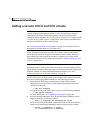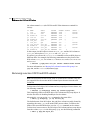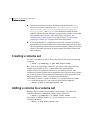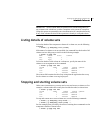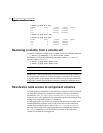
363Creating and administering volume sets
Listing details of volume sets
Caution: The -f (force) option must be specified if the volume being added, or
any volume in the volume set, is either a snapshot or the parent of a snapshot.
Using this option can potentially cause inconsistencies in a snapshot hierarchy
if any of the volumes involved in the operation is already in a snapshot chain.
Listing details of volume sets
To list the details of the component volumes of a volume set, use the following
command:
# vxvset [-g diskgroup] list [volset]
If the name of a volume set is not specified, the command lists the details of all
volume sets in a disk group, as shown in the following example:
# vxvset -g mydg list
NAME GROUP NVOLS CONTEXT
set1 mydg 3 -
set2 mydg 2 -
To list the details of each volume in a volume set, specify the name of the
volume set as an argument to the command:
# vxvset -g mydg list set1
VOLUME INDEX LENGTH KSTATE CONTEXT
vol1 0 12582912 ENABLED -
vol2 1 12582912 ENABLED -
vol3 2 12582912 ENABLED -
The context field contains details of any string that the application has set up
for the volume or volume set to tag its purpose.
Stopping and starting volume sets
Under some circumstances, you may need to stop and restart a volume set. For
example, a volume within the set may have become detached, as shown here:
# vxvset -g mydg list set1
VOLUME INDEX LENGTH KSTATE CONTEXT
vol1 0 12582912 DETACHED -
vol2 1 12582912 ENABLED -
vol3 2 12582912 ENABLED -
To stop and restart one or more volume sets, use the following commands:
# vxvset [-g diskgroup] stop volset ...
# vxvset [-g diskgroup] start volset ...
For the example given previously, the effect of running these commands on the
component volumes is shown below:
# vxvset -g mydg stop set1




